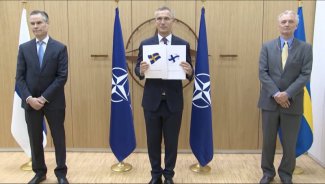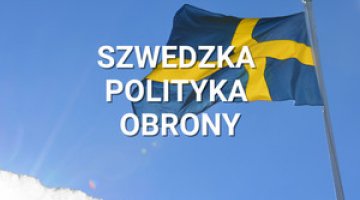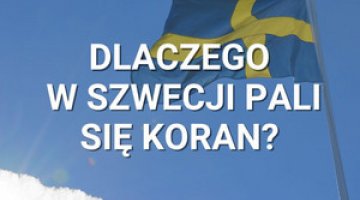Sweden and Finland on the threshold of NATO membership

On 17 May, the foreign ministers of Sweden and Finland signed their applications to join the North Atlantic Alliance, and these were officially submitted to NATO in Brussels a day later. This marked the end of a process of revolutionary speed to form internal political consensus, fundamentally changing the security policy of the two hitherto non-aligned states. The brutal Russian invasion of Ukraine caused a sudden change in public opinion in Finland, which influenced the position of the Finnish political parties. The expected turnaround in Helsinki’s security policy in turn influenced the stance of Sweden’s governing Social Democrats. During the accession process Sweden and Finland, with the help of the NATO member states, will have to remove Turkey’s objections to their NATO membership and be prepared for Russian retaliatory actions.
Finland: shaping a broad consensus
The Russian invasion of Ukraine undermined Finland’s security strategy. On the one hand, Finland had invested in its defence capabilities and increased military cooperation, primarily with Sweden, NATO and the US, while maintaining the possibility of joining NATO. On the other hand, it has been trying to develop political and economic cooperation with Russia to reduce the risk of bilateral tensions. The Russian invasion of Ukraine and the brutality of the Russian military campaign shocked Finnish society to the extent that their attitude towards NATO membership changed rapidly. Support for Finland’s accession to NATO rose from 24% to over 50% by the end of February and exceeded 60% in March. The change in public attitudes influenced the standing of the Finnish political parties. Although Finland’s president and the prime minister relatively early unofficially acknowledged the need to join NATO, they did not make explicit statements on this issue in public, trying to allow the process of a turnaround in Finnish security policy to be bottom-up in nature.
Before the Russian invasion, only one party in the centre-left government led by Sanna Marin favoured Finland’s NATO membership – the Swedish People’s Party, representing the Swedish-speaking minority (10 of 200 seats in parliament). The centre-right National Coalition Party (38 seats) was the only opposition party opting for accession. In April, the three centre-left coalition parties – the Centre Party (31 seats), the Greens (20 seats), and Prime Minister Marin’s Social Democracy (40 seats) – started to revise their positions. The coalition party Left Alliance (16 seats) ended up divided over the question of membership. The nationalist Finnish Party (38 seats), in the opposition, followed the general trend and pivoted to support NATO accession.
The preparations for taking an official decision to apply for membership began in the first half of March when the government announced the revision of its foreign and security policy strategy. The updated report on changes in the security environment presented in April did not include a recommendation to join NATO but provided the basis for further discussion in parliament. After a month of debates, on 12 May President Sauli Niinistö and Prime Minister Sanna Marin presented a joint statement in support of Finland’s NATO membership. Three days later, the president and the government adopted a short‘ Report on Finland’s Accession to the North Atlantic Treaty Organization’, stating that Finland would apply for NATO membership. President Niinistö informed the Russian president of this decision a day earlier in a telephone conversation. On 16 May, the debate in the Finnish parliament began. The vote showed overwhelming support for this decision, with 188 of the 200 MPs favouring the step, with eight against and three abstentions.
The cross-party consensus was accompanied by a further increase in public support for membership. In a poll at the beginning of May, as much as 76% of those questioned favoured Finland joining NATO, with only 12% against.[1] Public support in Finland may further rise to over 80%. This means that the Finnish government achieved its goal of gaining strong political and social support. This is now unlikely to change under the influence of Russian threats, blackmail or disinformation campaigns until the completion of the accession process.
Sweden: speeding up
The change in Finland’s security and defence policy influenced Stockholm’s decision to abandon its non-alignment status that superseded the 200-year policy of neutrality when it joined the EU. Sweden’s governing Social Democrats had until recently ruled out Swedish membership in NATO. Instead, they developed extensive military cooperation – with NATO and the US, and with Finland and other Nordic states. However, the Swedish Social Democrats, with partly an anti-NATO and anti-American stance and firmly in favour of nuclear disarmament, would not have taken this decision without the Finnish pivot. Being faced with a change in the policy of its primary partner in defence cooperation, the governing party faced a hard choice: either NATO membership or strategic solitude as the only non-aligned state in the Baltic Sea region. While Prime Minister Magdalena Andersson still publicly ruled out joining NATO at the beginning of March, she changed her mind a month later. She started to transform the position of her party and thus the government. Both processes were meant to be completed in late May/early June but were brought forward due to the pace of the debate in Finland.
On 13 May, a report on the impact of the Russian invasion of Ukraine on the country’s security policy was presented in the Riksdag (Swedish Parliament). The working group preparing the report, chaired by the ministers for foreign affairs and defence, included representatives of all the parties represented in parliament. According to the report’s conclusions, supported by all parties except the Left and Greens, Swedish NATO membership would raise the threshold for military conflicts and thus have a deterrent effect in northern Europe. Two days later, on 15 May, Magdalena Andersson, as leader of the Social Democrats, and the party’s secretary-general, announced the change in the party’s policy alongside support for Sweden’s NATO membership. A majority of the party’s 20-plus leadership opted for it after only a month of intra-party consultations. A survey of Social Democratic voters at the end of April showed that supporters of accession (47%) outnumbered opponents (21%), with 32% still undecided.[2] Ultimately, the Social Democrats’ favourable decision was subject to two conditions: opposition to the stationing of nuclear weapons and the deployment of permanent NATO bases on Swedish territory. After the publication of the parliamentary report and the change in the official attitude of the ruling Social Democrats, the following stages of the process proceeded at a dizzying pace.
The debate in the Riksdag on Sweden’s NATO membership on 16 May did not end in a vote, presumably also to avoid highlighting the divisions still existing within the Social Democrats. After the parliamentary discussion, Prime Minister Andersson announced broad support in the Riksdag for Swedish accession. The centre-right parties had come out in favour of membership earlier: Moderates (70 of 349 seats), Centre Party (31 seats), Christian Democrats (22 seats) and the Liberals (20 seats). On the day of the debate, the far-right party Sweden Democrats (62 seats), which had previously opposed membership, changed its stance. Among the left-wing parties, the Social Democrats (100 seats) are in favour of accession, while the Left Party (27 seats) and the Greens (16 seats) still oppose it.
Prime Minister Andersson announced the official government’s decision to apply for NATO membership after the Riksdag debate. The leader of the Moderates, the largest opposition party, accompanied her at the press conference and confirmed that the decision would not change if his party formed the government after the parliamentary elections scheduled for September. Recent polls have shown an increase in support for the largest parties: the Social Democrats (+26 seats according to Kantar Sifo) and the Moderates (+10 seats).[3] The Greens and Liberals, on the other hand, would not cross the electoral threshold. There are many indications that a minority government will again be formed by the Social Democrats, with Magdalena Andersson continuing as prime minister, if the centre-right parties do not decide to form a coalition with the hitherto isolated Sweden Democrats.
According to an opinion poll conducted in mid-May, 58% of those questioned supported Sweden’s NATO membership, 23% were against, and 19% had no opinion on it (Novus poll).[4] The public support in Sweden for NATO membership might soon fluctuate between 60–70%.
NATO accession process and membership prospects
Following the notification of Finland’s and Sweden’s aspirations to join NATO and a unanimous invitation from the 30 member states to enter accession negotiations, the talks will begin on the political, legal, resources (including the contribution to the common NATO budgets and military structures), information security and defence and military issues. Aspirant countries received Membership Action Plans (MAP) during previous enlargement processes. Due to the fulfilment by Finland and Sweden of the political, economic and military criteria and their close political-military cooperation with NATO in recent years, this will most likely be unnecessary. After the talks, the representatives of the 30 member states (most likely at the level of foreign ministers) will sign accession protocols, thereby consenting to both countries’ NATO membership. The ratification of both accession protocols in all member states, acceptance of the accession agreements in Sweden and Finland, and the depositing of the ratification documents with the State Department (the US is the depository of the Washington Treaty) will be necessary to complete the whole process.
Before submitting the formal application, both Finland and Sweden held intensive consultations with principal NATO members to gauge their position and secure their support for a rapid accession process. Talks were held primarily with the United States, the United Kingdom, France, Germany and Turkey, but also with Hungary and others. Stockholm and Helsinki were assured of support from all the allies. Moreover, they received informal security guarantees from the US, France and Germany, and signed bilateral “political declarations of solidarity” with the UK (implicitly, these will be in force during the interim period of ratification of the accession protocols).[5]
Stockholm and Helsinki were therefore taken aback by Turkey’s objections. Ankara does not seem to be opposed to their NATO membership in principle, but rather interested in seeing its demands being met; these include restrictions on the activities of Kurdish organisations in Sweden and Finland, both countries ending the embargo on arms deliveries, and the lifting of the blockade on the sale of F-16 aircraft by the US to Turkey. It has so far blocked the issuance of a formal invitation to both countries to negotiation talks in NATO. Intensive talks are underway between representatives of the three countries. Finland, Sweden and the USA are toning down the uncertainties related to Turkey’s opposition knowing, however, that Turkey will probably gain acceptance for at least some of its demands in the ongoing negotiations. How long this will drag out the accession process remains an open question. NATO enlargement to include these two Nordic states is seen by the USA and Western Europe as strategically important; the scenario of Turkey maintaining a permanent blockade in NATO seems unlikely, but should not be ruled out altogether.[6] Less important for the accession process are the objections expressed by the Croatian president, who is not supported on this issue by his country’s government and parliamentary majority. Both the accession process, which will take place in NATO most probably at the ministerial level, and the consent of the Croatian parliament are therefore not at risk from this direction.[7]
After joining NATO, Finland and Sweden will be covered by the Article 5 guarantees. This will mean that NATO defence planning will be extended to both countries. Joint planning will also ensure Finnish and Swedish participation in allied collective defence operations in Norway, the Baltic states and Poland. This will significantly raise the level of deterrence in the Nordic-Baltic region. Finland and Sweden will also commit to developing military capabilities in the framework of the NATO Defence Planning Process. The two countries are likely to contribute to the NATO Response Force (both to the Very High Readiness Joint Task Force and the Initial Follow-On Forces Group), to strengthen NATO Standing Naval Forces, and to take part in the Baltic and Icelandic Air Policing missions. Both countries might also send small Swedish and Finnish components to the allied presence in the Baltic states or possibly in Poland. Stockholm and Helsinki will also increase their participation in allied exercises which, in the future, will also be held on their territory. The participation of NATO allies in Finnish and Swedish national manoeuvres will also be enhanced. In terms of defence spending, Finland will possibly reach 2% of GDP next year, with an increasing trend in the coming years; Sweden plans to increase its defence budget to 2% of GDP in 2025 (if a centre-right government is formed after the September parliamentary elections) or in 2028 (if the Social Democrats remain in power).
Neither Finland nor Sweden is likely to apply for a permanent presence of NATO forces on their territory, although the establishment of small NATO liaison units should not be ruled out for either country. After their accession there might also be a discussion about establishing additional command structures for NATO operations in Northern Europe. The Swedish Social Democrats have announced their opposition to a permanent allied presence in the country. If it wins the election this party will also continue its commitment to nuclear disarmament initiatives, some of which are controversial among the NATO members. Sweden will not sign the Treaty on the Prohibition of Nuclear Weapons, but it will become (alongside Germany and Norway) an observer at the first meeting of the signatory states of the document. It will also continue its involvement in the Stockholm Initiative for Nuclear Disarmament. It might also take a cautious stance on issues of strengthening nuclear deterrence in NATO.
Finnish government officials have in turn announced that Finland will not apply any official self-restraint after becoming a NATO member. It may, however, be cautious about an allied presence on its territory due to concerns about Russia’s reactions, and it may justify its reluctance by pointing to the sufficient Finnish military capabilities in peacetime. According to the Finnish government, NATO membership will not affect the status of the Åland Islands, which under international agreements are demilitarised in peacetime and neutral in wartime (Finland is obliged to defend their neutrality). It remains an open question whether Finland will advocate in future a return to dialogue in the NATO-Russia Council retaining some elements of its hitherto policy of maintaining channels of dialogue and information exchange for greater predictability and stability in the Nordic-Baltic region.
How Russia views Sweden and Finland’s NATO membership
The Russian reaction to Finland and Sweden’s decisions to join NATO is complex and aimed at achieving several partly contradictory objectives. Firstly, Moscow wishes to create the impression that it has a peaceful attitude towards both countries and does not seek confrontation. The moderate tone of Russian official statements, especially at the highest level (president, foreign minister), is intended to achieve this. Secondly, the Russian government wants to reassure its own people and avoid the impression that the two countries’ accession to NATO is a failure of Russian policy and an additional cost of Russian aggression against Ukraine. In this regard, both the president and the foreign minister emphasise that these countries’ membership does not pose a threat to Russia and does not change the balance of power in Europe, not least because the two countries have been cooperating closely with NATO for some time and have been included in allied defence planning.
A further Russian aim is to cause alarm and intimidate Western societies and elites. This is in part intended to stimulate internal debates and disputes, both in these two countries and in Western Europe, regarding how prudent it is to change the non-aligned status of the two countries in favour of NATO membership. Here, the main role is played by lower-level officials (deputy foreign minister, MFA spokeswoman, parliamentarians) and experts loyal to the Kremlin. The former publicly use vague formulations which are intended to create a sense of a direct threat (the decision to join NATO unties Russia’s hands; there should be no illusion that Russia will come to terms with this decision; Finland and Sweden will become a war zone in the event of a conflict between Russia and NATO, which they would avoid if they remained outside of NATO). Experts articulate more tangible threats: Russia will strengthen the Baltic fleet, develop additional military forces along the border with Finland and place tactical nuclear weapons in its vicinity.
The main pragmatic Russian objective, however, is to influence the specific terms of Finland and Sweden’s NATO membership. Russia is interested in these states stipulating that they will not deploy nuclear weapons and/or ‘offensive systems’ on their territory, will not allow the permanent stationing of NATO troops, and will not develop military infrastructure for that purpose. This is evidently what is meant by the emphasis in the statements of the highest officials (the president and the foreign minister) that the Russian response in military-technical terms will depend on the real consequences that NATO enlargement will entail in military terms.
Finland and Sweden do not expect Russia to take direct military action against them. In their view, the Russian armed forces are too tied up in the war in Ukraine, although they can afford sabotage using special forces or long-range missile attacks. Their main concerns are expressed about possible Russian influence campaigns against the political elites and society in both countries, cyber and hybrid attacks on critical infrastructure, military exercises in the neighbourhood with aggressive scenarios, including the use of nuclear weapons, and/or violations of their airspace and territorial waters. Both countries are preparing for these scenarios.
Due to Finland’s refusal to pay in roubles, Russia has already announced the suspension of electricity exports to the country, where Russian supplies account for 10% of consumption. However, energy imports from Russia will be replaced by supplies from Sweden and by increasing domestic Finnish production, with the prospect of Finland being self-sufficient in this area in 2023. Helsinki is also ready for the scenario that Russia could suspend its gas exports to it. This will not be a major problem, as gas accounts for only 5% of Finland’s energy mix. The political decision to stop importing Russian gas by the end of 2022 has already been taken. Finland, among other measures, will lease a floating LNG terminal together with Estonia; the infrastructure to service it in Finland is expected to be ready by the end of 2022. Shortages in the coming months could be covered largely from the LNG terminal in Klaipeda.
[1] ‘Yle poll: Support for Nato membership soars to 76%‘, Yle, 9 May 2022, yle.fi.
[2] J. Wennö, ‘Allmänhetens tillit, tankar och beteende‘, Kantar Public, 29 April 2022, p. 4, kantarsifo.se.
[3] ‘Sifo Väljarbarometern‘, Kantar Sifo, 13 May 2022, kantarsifo.se.
[4] ‘Klar majoritet för Nato‘, Novus, 16 May 2022, novus.se.
[5] ‘Political declaration of solidarity‘, Regeringskansliet, 11 May 2022, regeringen.se.
[6] See K. Strachota (cooperation A. Michalski), ‘Turkey’s veto towards Finland’s and Sweden’s NATO membership bid?‘, OSW, 18 May 2022, osw.waw.pl.
[7] For details see B. Zawadewicz, ‘Pogróżki prezydenta Chorwacji dotyczące blokowania rozszerzenia NATO‘, OSW, 17 May 2022, osw.waw.pl.




